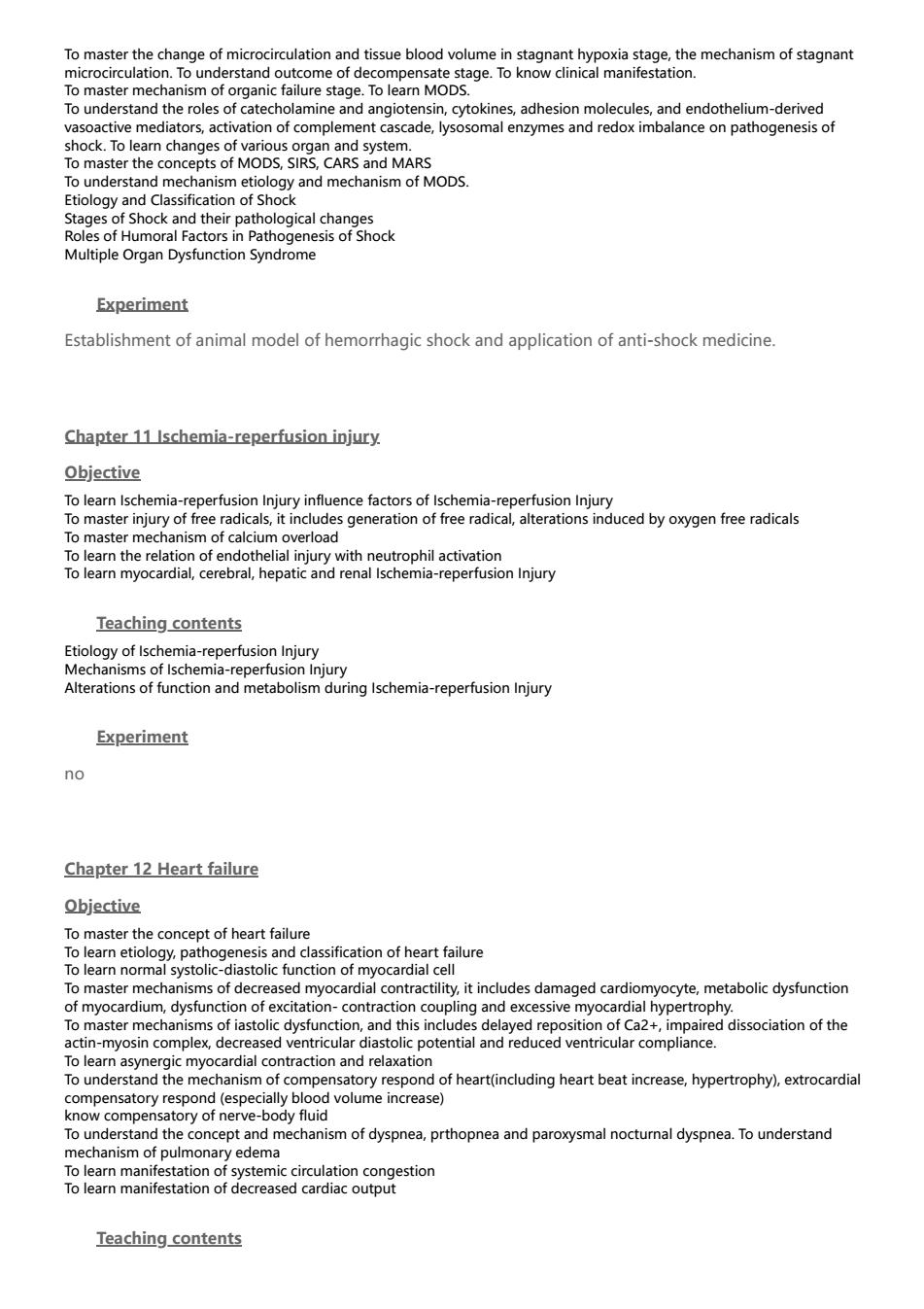正在加载图片...

omastth hang fthe meha of snant I0mastermechani5moto9anicaileg6T81emdgaoe mechanism etiology and mechanism of MODS. Etiology and Classifi ation of Shock oles of Humoral Factors in Pathogenesis of shock Multiple Organ Dysfunction Syndrome Experiment Establishment of animal model of hemorrhagic shock and application of anti-shock medicine Chapter 11 Ischemia-reperfusion ipjury. Objective To learn Ischemia-reperfusion Injury influence factors of Ischemia-reperfusion Injury free alterations induced byy free radicals 8moacp Teaching contents Alterations of function and metabolism during Ischemia-reperfusion Injury E赵periment Chapter 12 Heart failure To master the concept of heart failure To master mech sms of dec of of the actin-myosin complex,de entricular diastolic potential and reduced ventricular compliance. of heart(heart beat increase hypertrohy)xtrocardia compensatory respond (bl d volume increase) To understand the concept and mechanism of dyspnea,prthopnea and paroxysmal noctumal dyspnea.To understand nechanism of pulmonary edema ioleammanestat6n6fa8easgCarcacpleston Teaching contents To master the change of microcirculation and tissue blood volume in stagnant hypoxia stage, the mechanism of stagnant microcirculation. To understand outcome of decompensate stage. To know clinical manifestation. To master mechanism of organic failure stage. To learn MODS. To understand the roles of catecholamine and angiotensin, cytokines, adhesion molecules, and endothelium-derived vasoactive mediators, activation of complement cascade, lysosomal enzymes and redox imbalance on pathogenesis of shock. To learn changes of various organ and system. To master the concepts of MODS, SIRS, CARS and MARS To understand mechanism etiology and mechanism of MODS. Etiology and Classification of Shock Stages of Shock and their pathological changes Roles of Humoral Factors in Pathogenesis of Shock Multiple Organ Dysfunction Syndrome Experiment Establishment of animal model of hemorrhagic shock and application of anti-shock medicine. Chapter 11 Ischemia-reperfusion injury Objective To learn Ischemia-reperfusion Injury influence factors of Ischemia-reperfusion Injury To master injury of free radicals, it includes generation of free radical, alterations induced by oxygen free radicals To master mechanism of calcium overload To learn the relation of endothelial injury with neutrophil activation To learn myocardial, cerebral, hepatic and renal Ischemia-reperfusion Injury Teaching contents Etiology of Ischemia-reperfusion Injury Mechanisms of Ischemia-reperfusion Injury Alterations of function and metabolism during Ischemia-reperfusion Injury Experiment no Chapter 12 Heart failure Objective To master the concept of heart failure To learn etiology, pathogenesis and classification of heart failure To learn normal systolic-diastolic function of myocardial cell To master mechanisms of decreased myocardial contractility, it includes damaged cardiomyocyte, metabolic dysfunction of myocardium, dysfunction of excitation- contraction coupling and excessive myocardial hypertrophy. To master mechanisms of iastolic dysfunction, and this includes delayed reposition of Ca2+, impaired dissociation of the actin-myosin complex, decreased ventricular diastolic potential and reduced ventricular compliance. To learn asynergic myocardial contraction and relaxation To understand the mechanism of compensatory respond of heart(including heart beat increase, hypertrophy), extrocardial compensatory respond (especially blood volume increase) know compensatory of nerve-body fluid To understand the concept and mechanism of dyspnea, prthopnea and paroxysmal nocturnal dyspnea. To understand mechanism of pulmonary edema To learn manifestation of systemic circulation congestion To learn manifestation of decreased cardiac output Teaching contents